

Design by contract. A design by contract scheme The DbC approach assumes all client components that invoke an operation on a server component will meet the preconditions specified as required for that operation.
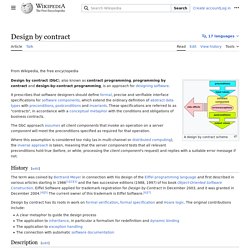
Where this assumption is considered too risky (as in multi-channel client-server or distributed computing) the opposite "defensive design" approach is taken, meaning that a server component tests (before or while processing a client's request) that all relevant preconditions hold true, and replies with a suitable error message if not. History[edit] Design by contract has its roots in work on formal verification, formal specification and Hoare logic.
The original contributions include: Description[edit] The central idea of DbC is a metaphor on how elements of a software system collaborate with each other on the basis of mutual obligations and benefits. The contract is semantically equivalent to a Hoare triple which formalises the obligations. What does contract expect? Abstraction principle (computer programming) When read as recommendation to the programmer, the abstraction principle can be generalized as the "don't repeat yourself" principle, which recommends avoiding the duplication of information in general, and also avoiding the duplication of human effort involved in the software development process.
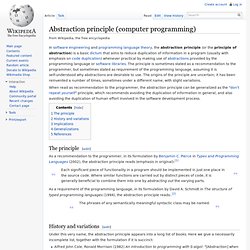
As a recommendation to the programmer, in its formulation by Benjamin C. Pierce in Types and Programming Languages (2002), the abstraction principle reads (emphasis in original):[1] Responsibility-driven design. Responsibility-driven design is a design technique in object-oriented programming.
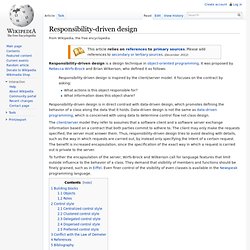
It was proposed by Rebecca Wirfs-Brock and Brian Wilkerson, who defined it as follows: Responsibility-driven design is inspired by the client/server model. It focuses on the contract by asking:What actions is this object responsible for? What information does this object share? Math linguistics circle. SOLID (object-oriented design) In computer programming, SOLID (Single responsibility, Open-closed, Liskov substitution, Interface segregation and Dependency inversion) is a mnemonic acronym introduced by Michael Feathers for the "first five principles" named by Robert C.

Martin[1][2] in the early 2000s[3] that stands for five basic principles of object-oriented programming and design. The principles when applied together intend to make it more likely that a programmer will create a system that is easy to maintain and extend over time.[3] The principles of SOLID are guidelines that can be applied while working on software to remove code smells by causing the programmer to refactor the software's source code until it is both legible and extensible. It is part of an overall strategy of agile and adaptive programming.[3] Rational Rhapsody 7.6 releases. Product family engineering. Product family engineering (PFE), also known as product line engineering, is a synonym for "domain engineering" created by the Software Engineering Institute, a term coined by James Neighbors in his 1980 dissertation at University of California, Irvine.
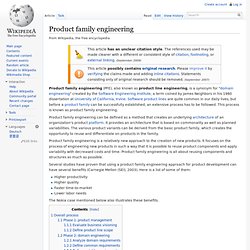
Software product lines are quite common in our daily lives, but before a product family can be successfully established, an extensive process has to be followed. This process is known as product family engineering. Product family engineering can be defined as a method that creates an underlying architecture of an organization's product platform.
It provides an architecture that is based on commonality as well as planned variabilities. The various product variants can be derived from the basic product family, which creates the opportunity to reuse and differentiate on products in the family. Product family engineering is a relatively new approach to the creation of new products. Overall process[edit] Phase 1: product management[edit]
Software development methodology. A software development methodology or system development methodology in software engineering is a framework that is used to structure, plan, and control the process of developing an information system.

Common methodologies include waterfall, prototyping, iterative and incremental development, spiral development, rapid application development, and extreme programming. A methodology can also include aspects of the development environment (i.e. IDEs), model-based development, computer aided software development, and the utilization of particular frameworks (i.e. programming libraries or other tools). Waterfall model. The unmodified "waterfall model".

Progress flows from the top to the bottom, like a cascading waterfall. The waterfall model is a sequential design process, used in software development processes, in which progress is seen as flowing steadily downwards (like a waterfall) through the phases of Conception, Initiation, Analysis, Design, Construction, Testing, Production/Implementation and Maintenance. The waterfall development model originates in the manufacturing and construction industries: highly structured physical environments in which after-the-fact changes are prohibitively costly, if not impossible.
Since no formal software development methodologies existed at the time, this hardware-oriented model was simply adapted for software development.[1] Design. More formally design has been defined as follows.
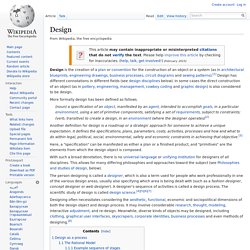
Rationalism. In epistemology, rationalism is the view that "regards reason as the chief source and test of knowledge"[1] or "any view appealing to reason as a source of knowledge or justification".[2] More formally, rationalism is defined as a methodology or a theory "in which the criterion of the truth is not sensory but intellectual and deductive".[3] Rationalists believe reality has an intrinsically logical structure.
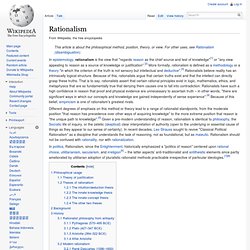
Because of this, rationalists argue that certain truths exist and that the intellect can directly grasp these truths. That is to say, rationalists assert that certain rational principles exist in logic, mathematics, ethics, and metaphysics that are so fundamentally true that denying them causes one to fall into contradiction. Philosophical usage[edit] Rationalism is often contrasted with empiricism. Theory of justification[edit] The theory of justification is the part of epistemology that attempts to understand the justification of propositions and beliefs.